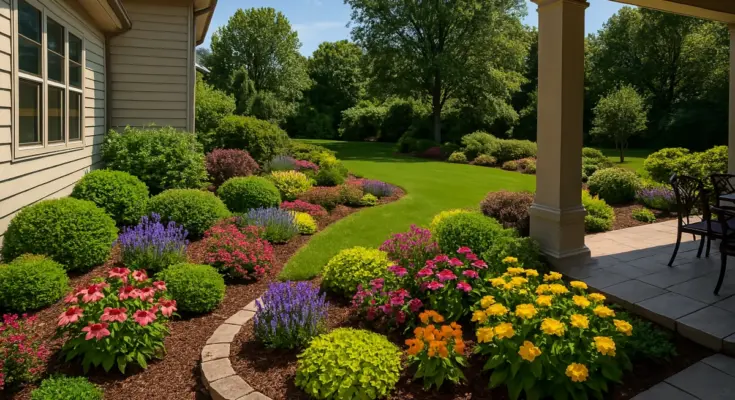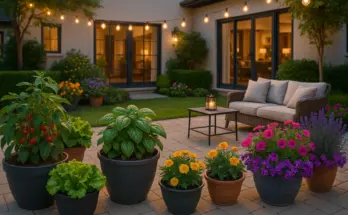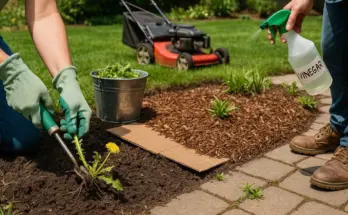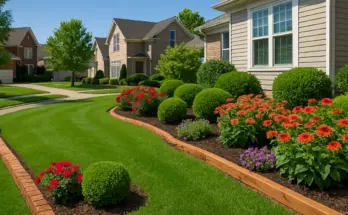Why Low-Maintenance Flower Beds?
Have you ever dreamed of a gorgeous flower bed that practically takes care of itself? We have too—and it’s totally possible. Low-maintenance flower beds offer all the beauty with a fraction of the effort. Whether you’re a beginner, a busy bee, or someone who just doesn’t love yard work, this guide is for you.
We’ll show you how to create stunning, easy-care flower beds that work in any space—from spacious yards to cozy patios. Along the way, we’ll share smart plant picks, design tips, and time-saving tricks to help you skip the stress and enjoy the blooms.
Even better, many of these ideas are budget-friendly and renter-approved.
So if you’re ready to enjoy your yard without the endless weeding and watering, you’re in the right place. Let’s dig into low-maintenance flower beds that fit your lifestyle and your space.
What Makes a Flower Bed Low-Maintenance?
When we think about low-maintenance flower beds, it’s all about making smart choices from the start. The right plants, the right layout, and a little prep work go a long way.
First, let’s talk about plants. Drought-tolerant varieties are a must. They thrive with little water and don’t need constant attention. Native plants are great too—they’re already adapted to our local climate. Just as important, we want to avoid high-maintenance options. Plants that need daily watering or are prone to pests will only create extra work. Invasive species can also take over and make your life harder, so it’s best to skip them.
Next, design plays a huge role. We don’t have to be landscape architects to keep it simple. Grouping plants with similar water and sunlight needs makes care much easier. Also, adding edging helps define the space and keeps grass or weeds out.
Mulching is another secret weapon. It locks in moisture, blocks weeds, and gives our flower beds a tidy look. Plus, it cuts back on watering time.
Before planting anything, though, we need to prep the soil. Healthy soil means healthier plants, which means less work later. A little compost or topsoil now saves time down the road.
With thoughtful planning, low-maintenance flower beds are easy to create—and even easier to enjoy
Choose the Right Location
Choosing the right location is one of the easiest ways to set up low-maintenance flower beds for success. Before we plant a single flower, we need to consider how much sunlight the spot gets. Some plants love full sun, while others thrive in shade. If we match the plant to the light, we’ll spend less time fixing problems later.
It also helps to think about water. Placing our flower beds near a hose or irrigation system makes watering quicker and easier. If we have to drag a hose across the yard, we might end up skipping it. And that’s when plants suffer.
Paths and walkways can also work in our favor. A flower bed next to a sidewalk or patio is easy to reach and admire. It also helps us spot weeds or issues before they get out of hand.
Finally, we should look at what’s already in our yard. Existing trees, fences, or slopes can offer natural shade, wind protection, or drainage. Instead of fighting the landscape, we can work with it.
By picking the right spot from the start, we’ll save ourselves a lot of effort—and our low-maintenance flower beds will thank us.
Best Low-Maintenance Plants to Use
Perennials are a beginner’s best friend. Once we plant them, they return year after year with minimal effort. Coneflowers are tough, colorful, and attract pollinators. Black-eyed Susans are just as hardy and bloom for weeks. Hostas are perfect for shady spots and bring lush texture to any bed. Because they’re reliable, perennials are ideal for low-maintenance flower beds.
Shrubs for Structure and Style
Shrubs add height, shape, and long-lasting beauty. Lavender smells amazing and thrives in dry soil with full sun. Boxwoods bring neat, green structure all year long. Hydrangeas offer big blooms with very little fuss—just give them some shade and water now and then. With the right mix, shrubs help fill space and reduce the need for constant replanting.
Groundcovers That Do the Dirty Work
Groundcovers are low-growing plants that spread out and block weeds. Creeping Jenny adds a splash of chartreuse and grows fast. Sedum is a succulent that loves poor soil and full sun. Ajuga brings rich color and grows well in shade. These plants help keep the soil moist and cool, which means less watering for us.
Bonus: Native Plants Make Life Easier
Native plants are already adapted to our local climate and soil. They need less water, fewer fertilizers, and rarely attract pests. Because they’re built for our environment, they practically take care of themselves. Including natives in low-maintenance flower beds is one of the smartest moves we can make.
Keep It Simple
Here’s a helpful tip: don’t go overboard with plant variety. While it’s tempting to try everything, fewer plant types make care easier. Grouping similar plants also helps with watering and pruning. So instead of planting ten different flowers, we can choose three or four that thrive together.
By picking the right mix of perennials, shrubs, groundcovers, and natives, we can build low-maintenance flower beds that look amazing and ask very little in return.
Design Ideas for Low-Maintenance Flower Beds
When it comes to low-maintenance flower beds, a simple layout saves us time and effort. Curved edges look natural and are easy to mow around. Borders help define the space and keep things tidy. Layering—tall plants in back, short ones in front—adds visual interest without extra work.
Raised Beds vs. In-Ground
Raised beds are great if we want better control over soil and drainage. They also make planting and weeding easier on our backs. However, in-ground beds can look more natural and blend with the yard. Both options work well—it just depends on what fits our space and needs best.
Group by Water and Light Needs
One of the smartest things we can do is group plants by their sunlight and water preferences. This way, we don’t have to treat each plant differently. For example, sun-loving, drought-tolerant plants go together. Shade-lovers stick to the same side. It’s a small step that makes care much easier.
Use Fabric and Edging for Control
To cut down on weeding, we can use landscape fabric under mulch. It keeps weeds from popping up and helps soil stay moist. Edging, like metal or stone, keeps mulch and plants in place. Together, they make our flower beds look polished and keep maintenance low.
With just a few design tweaks, we can create low-maintenance flower beds that are beautiful, easy to manage, and built to last.
Tips to Reduce Ongoing Maintenance
Once our low-maintenance flower beds are planted, a few smart habits will keep them looking great with minimal effort.
First, let’s talk about mulch. A two- to three-inch layer of mulch helps suppress weeds and lock in moisture. It also keeps the soil cooler in summer and gives our beds a tidy look. As mulch breaks down, it even improves soil health.
Next, we can feed our plants with slow-release fertilizers or compost. These options provide nutrients over time, so we don’t need to fertilize often. Compost also boosts soil structure and holds moisture better, which means less watering.
Speaking of watering, drip irrigation or soaker hoses are a game changer. They deliver water directly to the roots, reducing waste and saving us time. Plus, they’re easy to set on a timer so we don’t have to think about it.
Even low-maintenance flower beds need seasonal check-ins. In spring, we can refresh mulch, remove dead leaves, and divide any overgrown plants. During summer, we just need to watch for weeds, prune when needed, and check our watering system. In fall, it’s a good time to cut back perennials and prepare the bed for winter.
With these easy tips, we’ll spend more time enjoying our garden—and less time working in it.
Small-Space & Budget-Friendly Ideas
Low-maintenance flower beds aren’t just for big yards—they’re perfect for small spaces and tight budgets too. If we live in an apartment or rental, containers are a great option. They fit on patios, balconies, or front steps. Plus, we can move them around to catch the sun or avoid bad weather.
To save money, we can repurpose materials we already have. Old bricks, stones, or even wooden pallets can become borders or raised beds. Not only does this reduce waste, but it also adds a fun, creative touch to our garden.
We can also grow our garden by swapping plants or taking cuttings. Many perennials and groundcovers can be divided or rooted in water. Local plant swaps, friends, or neighbors are great resources. This way, we expand our low-maintenance flower beds without spending a dime.
Even in a small space, these simple ideas let us enjoy the beauty of flowers without the fuss or the cost.
Your Easy Path to a Beautiful Yard
Creating low-maintenance flower beds is easier than we might think. With the right plants, smart design, and simple care, we can enjoy lasting beauty without the stress. We’ve looked at easy plant choices, clever layouts, and ways to save time and money. Even better, these ideas work for any yard or budget.
As we get started, it’s okay to keep things small. One simple flower bed can boost our confidence and brighten our space. Of course, low-maintenance doesn’t mean zero work—but it’s close. A little effort upfront leads to a garden that mostly takes care of itself.
Let’s grab a shovel, pick a sunny spot, and enjoy the easy path to a more beautiful yard.
Frequently Asked Questions (FAQ) Low-Maintenance Flower Beds
1. What are the best plants for low-maintenance flower beds? Look for perennials like Coneflowers, Black-eyed Susans, and Hostas. Drought-tolerant shrubs and native plants also work great.
2. How often do I need to water a low-maintenance flower bed? It depends on the plants and climate, but most only need watering once a week—less if you use mulch or drought-tolerant plants.
3. Can I have low-maintenance flower beds in full shade? Absolutely! Try Hostas, Ferns, Ajuga, or other shade-loving plants that thrive with minimal sunlight and care.
4. Do I need to fertilize low-maintenance flower beds? Not often. Slow-release fertilizer or compost in the spring is usually enough for the whole growing season.
5. What’s the easiest way to keep weeds out? Mulch is your best friend! You can also use landscape fabric and edging to block weeds and keep everything neat.




